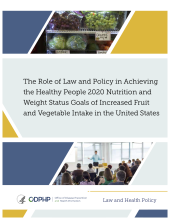This content was part of the Healthy People 2020 Law and Health Policy project, which ended in 2020.
Using Law and Policy to Increase Fruit and Vegetable Intake in the United States
This page offers a summary of the first in a series of reports that highlighted the practical application of law and policy to improve health across the nation. The reports presented evidence-based policy solutions that community and tribal leaders, government officials, public health professionals, health care providers, lawyers, and social service providers could use in their own communities. Success stories, or Bright Spots, connected with each report illustrated how communities had used law and policy to help meet their health improvement goals and achieve Healthy People targets.
The report, The Role of Law and Policy in Achieving the Healthy People 2020 Nutrition and Weight Status Goals of Increased Fruit and Vegetable Intake in the United States, documented policy solutions that could help communities increase access to and intake of fruits and vegetables in support of Healthy People 2020 nutrition objectives.
Download Fact Sheet [PDF - 929 KB]
Key Finding: Unequal Access Creates Disparities
- Only 1 in 10 U.S. adults eat the recommended amount of fruits or vegetables each day,1 and 1 in 10 American children ages 2 to 17 don’t consume fruits or vegetables at all on a daily basis.2
- Along with low levels of fruit and vegetable intake in the U.S. population overall, there are significant disparities by race, ethnicity, geography, and socio-economic status.
- There was little to no detectable change in the age-adjusted mean daily intake of fruits or vegetables—specifically, dark green vegetables, red and orange vegetables, and beans and peas by those age 2 years and older between 2005–2008 and 2009–2012.
- Factors that affect dietary patterns, including fruit and vegetable intake, include the availability of foods where people live, work, and study; community resources, such as public transit or sidewalks to access grocery stores; and the social, political, and economic factors that shape the overall food environment.3
Featured Graphic: Social-Ecological Model for Understanding Factors that Shape Fruit and Vegetable Access and Intake
Key Finding: Communities Can Use Laws and Policies to Promote Adequate Intake of Fruits and Vegetables
- Federal, state, tribal, and local governments each have unique opportunities to use their powers as policy levers to influence where fruits and vegetables are grown, distributed, sold, marketed, and served.
- These, in turn, can shape people’s access to and intake of fruits and vegetables.
- These policy levers include: spending on specific programs, direct regulation of businesses, altering the built environment, altering the socio-economic environment, changing the informational environment, and deregulation when laws act as a barrier to health.
Featured Graphic: Policy Levers that Promote Fruit and Vegetable Access and Intake
Past Webinar
From Policy to Plate: Increasing Fruit and Vegetable Intake Through Accessibility, Affordability, and Demand
This webinar discussed the impact of laws and policies on increasing fruit and vegetable intake, improving nutrition, and making food accessible and affordable. Learn more.
Key Finding: Early Child Care Settings and Schools Offer Opportunities to Shape Lifelong Behaviors
- Healthy eating in early childhood is critical to establishing lifelong healthy eating patterns.4
- An estimated 75% of children under age 6 attend an early care and education (ECE) program. Yet few states restrict the availability of low-nutrition, energy-dense foods in child care settings.
- Public primary and secondary schools provide an unparalleled opportunity to influence the eating habits of millions of children.
- Government action to set strong and specific nutrition standards for school food can increase student fruit and vegetable intake.
Key Finding: Polices in Worksites, Retail Food Outlets, and Elsewhere Can Also Improve Intake
- Food standards and purchasing policies in government worksites, institutions, or properties open to the public can affect the food choices of hundreds of millions of individuals.
- Private worksites represent an opportunity to increase fruit and vegetable intake in the general population and to change social and environmental norms.5
- Stores and restaurants play a critical role in food availability and purchasing decisions. In retail settings, laws and policies can influence: the affordability of fruits and vegetables, geographic access to businesses that sell fresh fruits and vegetables, and the marketing of fruits and vegetables (including in restaurants).
- Community interventions that can increase fruit and vegetable intake among populations with low socio-economic status include laws and policies that influence urban agriculture approaches, the availability of community gardens, fruits and vegetables in community food banks, and SNAP-Ed nutrition education classes.
Conclusion: Areas of Opportunity and Future Direction
The Healthy People 2020 objectives related to increasing fruit and vegetable intake set ambitious targets given current national intake patterns. To be most effective, laws and policies designed to meet these targets will need to be both innovative and based upon the best scientific research.
To help the Nation meet these health objectives, it’s important to:
- Continue to implement laws and policies related to nutrition standards
- Continue to advance alignment efforts among all federal food programs and policies
- Encourage opportunities for policy innovations at the state and local levels
- Consider geography, environment, and community needs in policy development
- Expand the focus on reaching young children
- Conduct rigorous evaluations of existing programs and policies
Taking the steps listed above will help ensure that all Americans live in communities with environments and policies that adequately support healthy eating.
Related Healthy People 2020 Objectives
- NWS-14: Increase the contribution of fruits to the diets of the population aged 2 years and older
- NWS-15.1: Increase the contribution of total vegetables to the diets of the population aged 2 years and older
- NWS-15.2: Increase the contribution of dark green vegetables, red and orange vegetables, and beans and peas to the diets of the population aged 2 years and older
1. Lee-Kwan SH, Moore LV, Blanck HM, et al. Disparities in state-specific adult fruit and vegetable consumption — United States, 2015.MMWR. 2017;66:1241–1247.
2. Nielsen SJ, Rossen LM, Harris DM, Odgen CL. Fruit and vegetable consumption of US Youth, 2009-2010. NCHS Data Brief [Internet]. 2014 July [cited 2016 Jun 29];156:1–8. Available from: http://www.ncbi.nlm.nih.gov/pubmed/25027507.
3. Stokols D. Translating social ecological theory into guidelines for community health promotion. Am J Health Promot. 1996 Mar–Apr;10(4):282–98.
4. Birch LL, Doub AE. Learning to eat: Birth to age 2 y. Am J Clin Nutr. 2014;99(Suppl):723S–28S.
5 Sorenson G, Stoddard A, Peterson K, Cohen N, Hunt MK, Stein E, et al. Increasing fruit and vegetable consumption through worksites and families in the Treatwell 5-a-day study. Am J Public Health [Internet]. 1999;(89)1:54–60. Available from: http://www.ncbi.nlm.nih.gov/pmc/articles/PMC1508509/pdf/amjph00001-0056.pdf.



